Comprehensive Analysis of the UK Retail Industry Market Structure
VerifiedAdded on 2020/05/04
|8
|1714
|141
Report
AI Summary
This report provides an analysis of the market structure within the UK retail industry, highlighting its oligopolistic nature and the dominance of key players like Tesco. It examines the factors influencing competition and pricing within the market, including the interdependence of retailers and the presence of entry barriers. The report also identifies the key success factors for businesses operating in this industry, such as product differentiation, brand marketing, competitive intelligence, and innovation. It discusses the impact of government policies and the importance of understanding market dynamics, including consumer behavior and competitor strategies. The conclusion emphasizes the significance of non-collusive competition and effective marketing strategies for achieving success in the UK retail market.
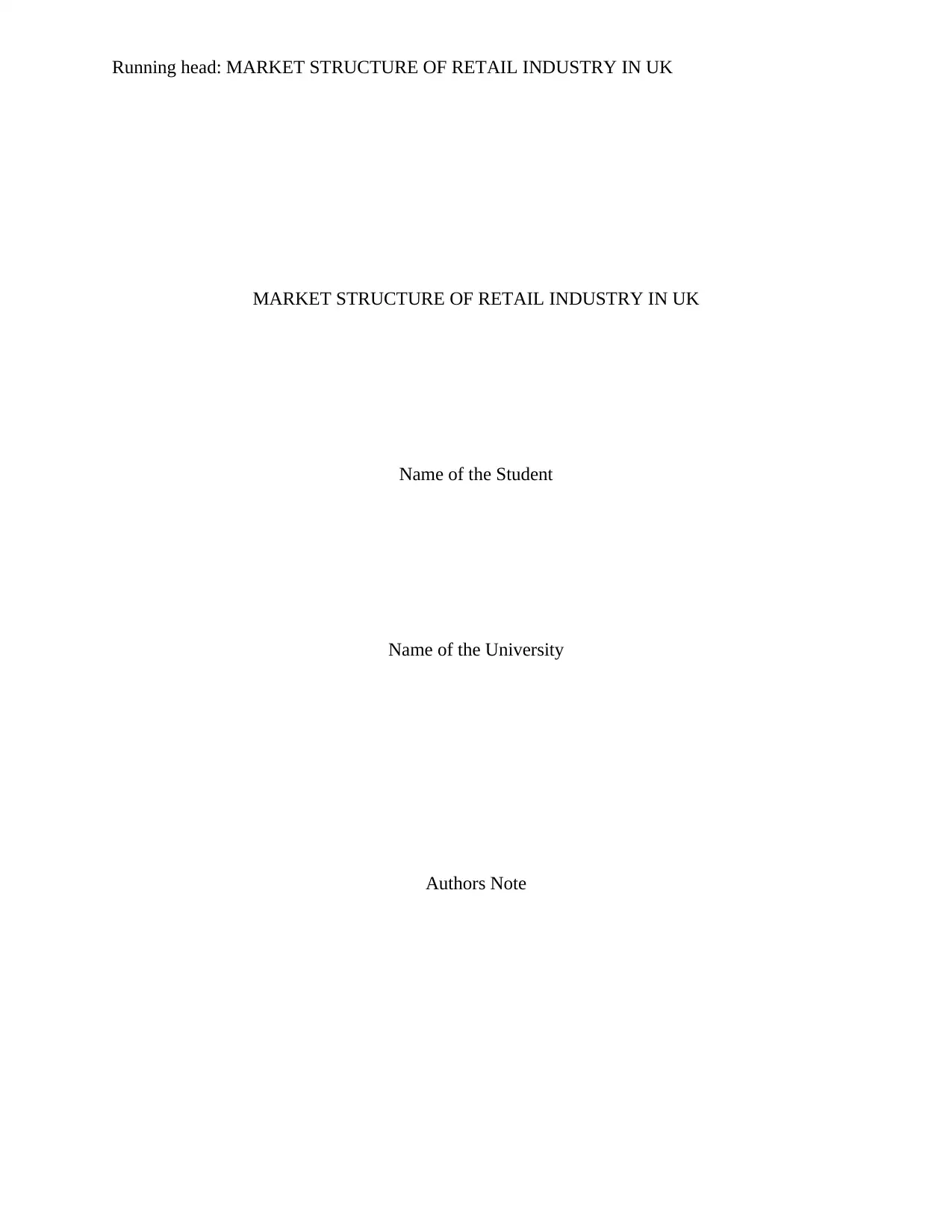
Running head: MARKET STRUCTURE OF RETAIL INDUSTRY IN UK
MARKET STRUCTURE OF RETAIL INDUSTRY IN UK
Name of the Student
Name of the University
Authors Note
MARKET STRUCTURE OF RETAIL INDUSTRY IN UK
Name of the Student
Name of the University
Authors Note
Paraphrase This Document
Need a fresh take? Get an instant paraphrase of this document with our AI Paraphraser
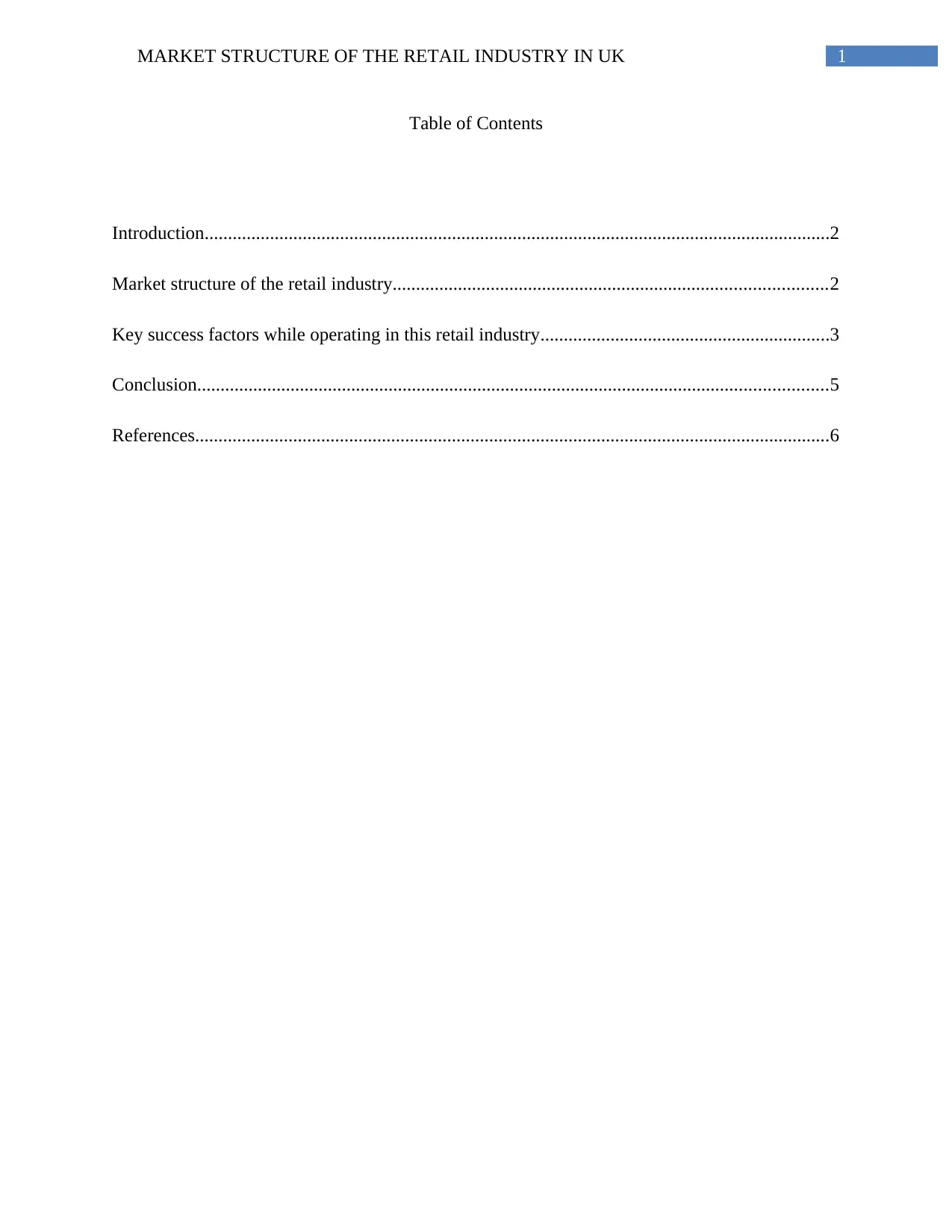
1MARKET STRUCTURE OF THE RETAIL INDUSTRY IN UK
Table of Contents
Introduction......................................................................................................................................2
Market structure of the retail industry.............................................................................................2
Key success factors while operating in this retail industry..............................................................3
Conclusion.......................................................................................................................................5
References........................................................................................................................................6
Table of Contents
Introduction......................................................................................................................................2
Market structure of the retail industry.............................................................................................2
Key success factors while operating in this retail industry..............................................................3
Conclusion.......................................................................................................................................5
References........................................................................................................................................6
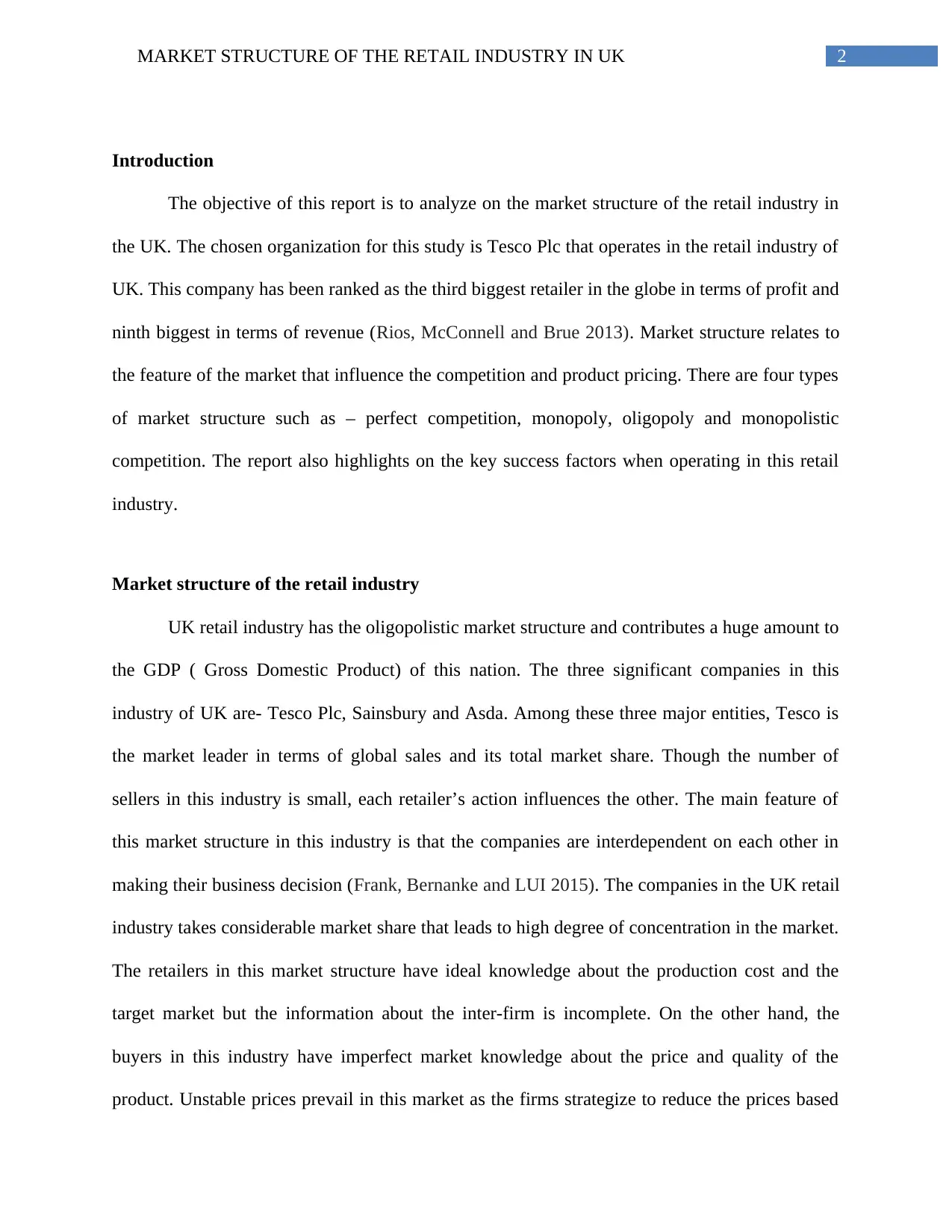
2MARKET STRUCTURE OF THE RETAIL INDUSTRY IN UK
Introduction
The objective of this report is to analyze on the market structure of the retail industry in
the UK. The chosen organization for this study is Tesco Plc that operates in the retail industry of
UK. This company has been ranked as the third biggest retailer in the globe in terms of profit and
ninth biggest in terms of revenue (Rios, McConnell and Brue 2013). Market structure relates to
the feature of the market that influence the competition and product pricing. There are four types
of market structure such as – perfect competition, monopoly, oligopoly and monopolistic
competition. The report also highlights on the key success factors when operating in this retail
industry.
Market structure of the retail industry
UK retail industry has the oligopolistic market structure and contributes a huge amount to
the GDP ( Gross Domestic Product) of this nation. The three significant companies in this
industry of UK are- Tesco Plc, Sainsbury and Asda. Among these three major entities, Tesco is
the market leader in terms of global sales and its total market share. Though the number of
sellers in this industry is small, each retailer’s action influences the other. The main feature of
this market structure in this industry is that the companies are interdependent on each other in
making their business decision (Frank, Bernanke and LUI 2015). The companies in the UK retail
industry takes considerable market share that leads to high degree of concentration in the market.
The retailers in this market structure have ideal knowledge about the production cost and the
target market but the information about the inter-firm is incomplete. On the other hand, the
buyers in this industry have imperfect market knowledge about the price and quality of the
product. Unstable prices prevail in this market as the firms strategize to reduce the prices based
Introduction
The objective of this report is to analyze on the market structure of the retail industry in
the UK. The chosen organization for this study is Tesco Plc that operates in the retail industry of
UK. This company has been ranked as the third biggest retailer in the globe in terms of profit and
ninth biggest in terms of revenue (Rios, McConnell and Brue 2013). Market structure relates to
the feature of the market that influence the competition and product pricing. There are four types
of market structure such as – perfect competition, monopoly, oligopoly and monopolistic
competition. The report also highlights on the key success factors when operating in this retail
industry.
Market structure of the retail industry
UK retail industry has the oligopolistic market structure and contributes a huge amount to
the GDP ( Gross Domestic Product) of this nation. The three significant companies in this
industry of UK are- Tesco Plc, Sainsbury and Asda. Among these three major entities, Tesco is
the market leader in terms of global sales and its total market share. Though the number of
sellers in this industry is small, each retailer’s action influences the other. The main feature of
this market structure in this industry is that the companies are interdependent on each other in
making their business decision (Frank, Bernanke and LUI 2015). The companies in the UK retail
industry takes considerable market share that leads to high degree of concentration in the market.
The retailers in this market structure have ideal knowledge about the production cost and the
target market but the information about the inter-firm is incomplete. On the other hand, the
buyers in this industry have imperfect market knowledge about the price and quality of the
product. Unstable prices prevail in this market as the firms strategize to reduce the prices based
⊘ This is a preview!⊘
Do you want full access?
Subscribe today to unlock all pages.

Trusted by 1+ million students worldwide
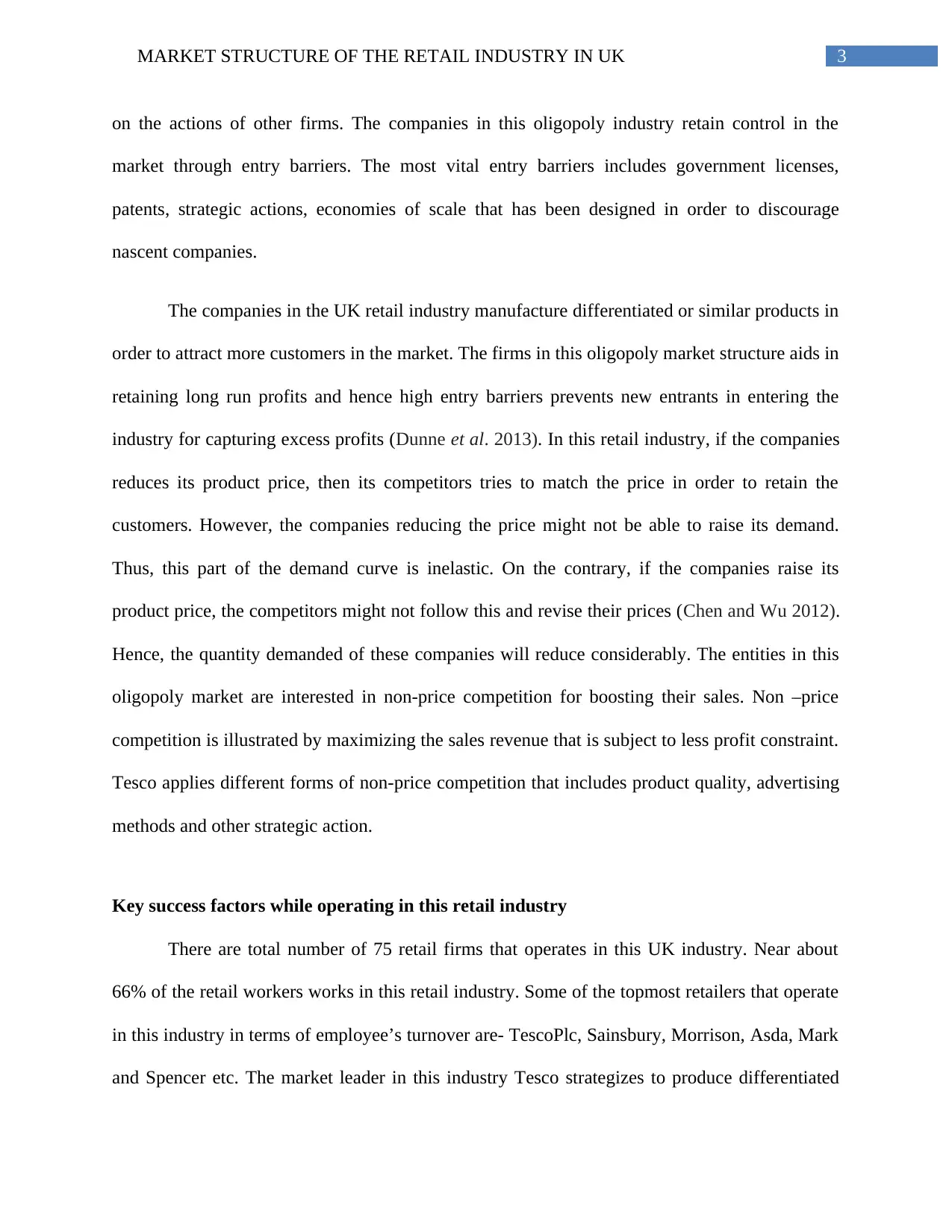
3MARKET STRUCTURE OF THE RETAIL INDUSTRY IN UK
on the actions of other firms. The companies in this oligopoly industry retain control in the
market through entry barriers. The most vital entry barriers includes government licenses,
patents, strategic actions, economies of scale that has been designed in order to discourage
nascent companies.
The companies in the UK retail industry manufacture differentiated or similar products in
order to attract more customers in the market. The firms in this oligopoly market structure aids in
retaining long run profits and hence high entry barriers prevents new entrants in entering the
industry for capturing excess profits (Dunne et al. 2013). In this retail industry, if the companies
reduces its product price, then its competitors tries to match the price in order to retain the
customers. However, the companies reducing the price might not be able to raise its demand.
Thus, this part of the demand curve is inelastic. On the contrary, if the companies raise its
product price, the competitors might not follow this and revise their prices (Chen and Wu 2012).
Hence, the quantity demanded of these companies will reduce considerably. The entities in this
oligopoly market are interested in non-price competition for boosting their sales. Non –price
competition is illustrated by maximizing the sales revenue that is subject to less profit constraint.
Tesco applies different forms of non-price competition that includes product quality, advertising
methods and other strategic action.
Key success factors while operating in this retail industry
There are total number of 75 retail firms that operates in this UK industry. Near about
66% of the retail workers works in this retail industry. Some of the topmost retailers that operate
in this industry in terms of employee’s turnover are- TescoPlc, Sainsbury, Morrison, Asda, Mark
and Spencer etc. The market leader in this industry Tesco strategizes to produce differentiated
on the actions of other firms. The companies in this oligopoly industry retain control in the
market through entry barriers. The most vital entry barriers includes government licenses,
patents, strategic actions, economies of scale that has been designed in order to discourage
nascent companies.
The companies in the UK retail industry manufacture differentiated or similar products in
order to attract more customers in the market. The firms in this oligopoly market structure aids in
retaining long run profits and hence high entry barriers prevents new entrants in entering the
industry for capturing excess profits (Dunne et al. 2013). In this retail industry, if the companies
reduces its product price, then its competitors tries to match the price in order to retain the
customers. However, the companies reducing the price might not be able to raise its demand.
Thus, this part of the demand curve is inelastic. On the contrary, if the companies raise its
product price, the competitors might not follow this and revise their prices (Chen and Wu 2012).
Hence, the quantity demanded of these companies will reduce considerably. The entities in this
oligopoly market are interested in non-price competition for boosting their sales. Non –price
competition is illustrated by maximizing the sales revenue that is subject to less profit constraint.
Tesco applies different forms of non-price competition that includes product quality, advertising
methods and other strategic action.
Key success factors while operating in this retail industry
There are total number of 75 retail firms that operates in this UK industry. Near about
66% of the retail workers works in this retail industry. Some of the topmost retailers that operate
in this industry in terms of employee’s turnover are- TescoPlc, Sainsbury, Morrison, Asda, Mark
and Spencer etc. The market leader in this industry Tesco strategizes to produce differentiated
Paraphrase This Document
Need a fresh take? Get an instant paraphrase of this document with our AI Paraphraser
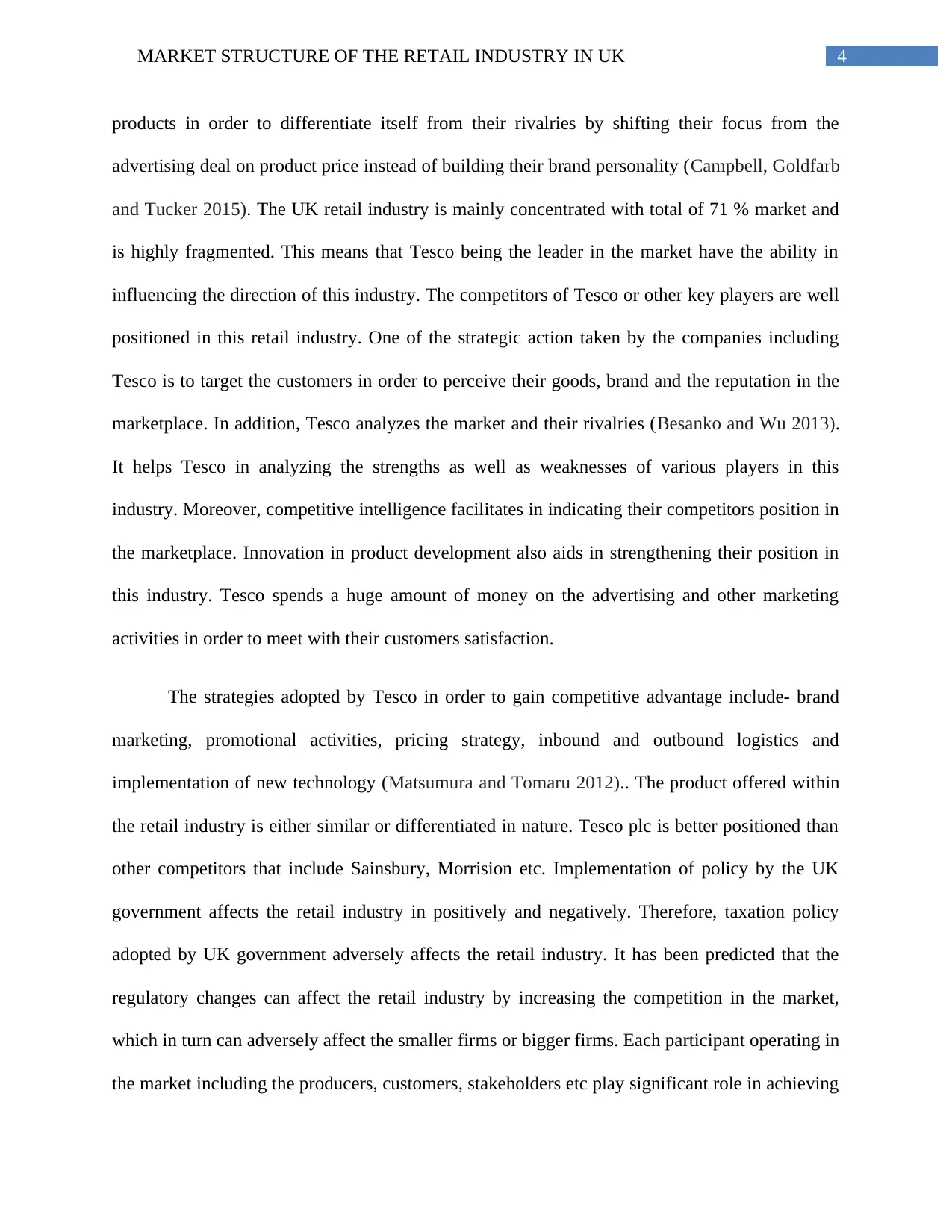
4MARKET STRUCTURE OF THE RETAIL INDUSTRY IN UK
products in order to differentiate itself from their rivalries by shifting their focus from the
advertising deal on product price instead of building their brand personality (Campbell, Goldfarb
and Tucker 2015). The UK retail industry is mainly concentrated with total of 71 % market and
is highly fragmented. This means that Tesco being the leader in the market have the ability in
influencing the direction of this industry. The competitors of Tesco or other key players are well
positioned in this retail industry. One of the strategic action taken by the companies including
Tesco is to target the customers in order to perceive their goods, brand and the reputation in the
marketplace. In addition, Tesco analyzes the market and their rivalries (Besanko and Wu 2013).
It helps Tesco in analyzing the strengths as well as weaknesses of various players in this
industry. Moreover, competitive intelligence facilitates in indicating their competitors position in
the marketplace. Innovation in product development also aids in strengthening their position in
this industry. Tesco spends a huge amount of money on the advertising and other marketing
activities in order to meet with their customers satisfaction.
The strategies adopted by Tesco in order to gain competitive advantage include- brand
marketing, promotional activities, pricing strategy, inbound and outbound logistics and
implementation of new technology (Matsumura and Tomaru 2012).. The product offered within
the retail industry is either similar or differentiated in nature. Tesco plc is better positioned than
other competitors that include Sainsbury, Morrision etc. Implementation of policy by the UK
government affects the retail industry in positively and negatively. Therefore, taxation policy
adopted by UK government adversely affects the retail industry. It has been predicted that the
regulatory changes can affect the retail industry by increasing the competition in the market,
which in turn can adversely affect the smaller firms or bigger firms. Each participant operating in
the market including the producers, customers, stakeholders etc play significant role in achieving
products in order to differentiate itself from their rivalries by shifting their focus from the
advertising deal on product price instead of building their brand personality (Campbell, Goldfarb
and Tucker 2015). The UK retail industry is mainly concentrated with total of 71 % market and
is highly fragmented. This means that Tesco being the leader in the market have the ability in
influencing the direction of this industry. The competitors of Tesco or other key players are well
positioned in this retail industry. One of the strategic action taken by the companies including
Tesco is to target the customers in order to perceive their goods, brand and the reputation in the
marketplace. In addition, Tesco analyzes the market and their rivalries (Besanko and Wu 2013).
It helps Tesco in analyzing the strengths as well as weaknesses of various players in this
industry. Moreover, competitive intelligence facilitates in indicating their competitors position in
the marketplace. Innovation in product development also aids in strengthening their position in
this industry. Tesco spends a huge amount of money on the advertising and other marketing
activities in order to meet with their customers satisfaction.
The strategies adopted by Tesco in order to gain competitive advantage include- brand
marketing, promotional activities, pricing strategy, inbound and outbound logistics and
implementation of new technology (Matsumura and Tomaru 2012).. The product offered within
the retail industry is either similar or differentiated in nature. Tesco plc is better positioned than
other competitors that include Sainsbury, Morrision etc. Implementation of policy by the UK
government affects the retail industry in positively and negatively. Therefore, taxation policy
adopted by UK government adversely affects the retail industry. It has been predicted that the
regulatory changes can affect the retail industry by increasing the competition in the market,
which in turn can adversely affect the smaller firms or bigger firms. Each participant operating in
the market including the producers, customers, stakeholders etc play significant role in achieving
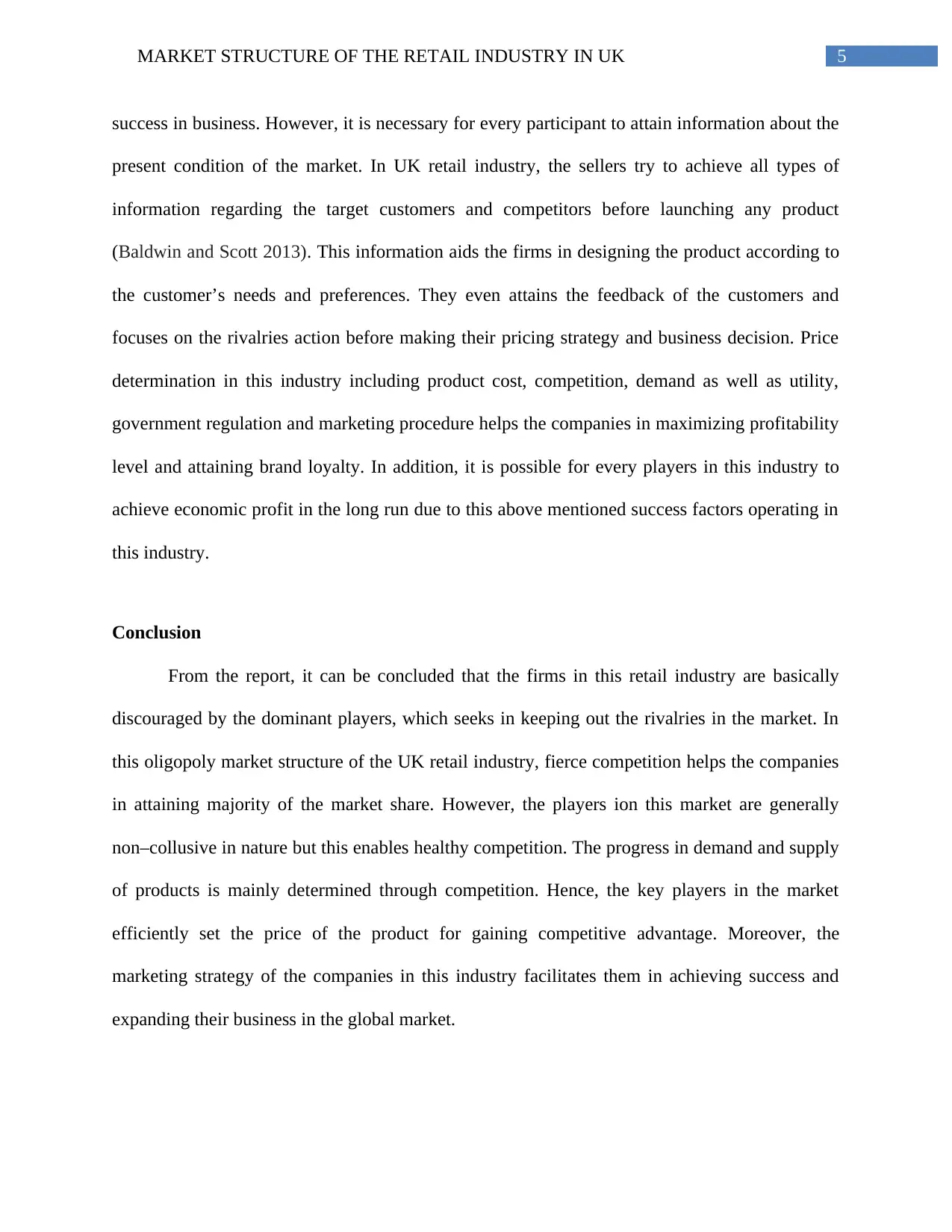
5MARKET STRUCTURE OF THE RETAIL INDUSTRY IN UK
success in business. However, it is necessary for every participant to attain information about the
present condition of the market. In UK retail industry, the sellers try to achieve all types of
information regarding the target customers and competitors before launching any product
(Baldwin and Scott 2013). This information aids the firms in designing the product according to
the customer’s needs and preferences. They even attains the feedback of the customers and
focuses on the rivalries action before making their pricing strategy and business decision. Price
determination in this industry including product cost, competition, demand as well as utility,
government regulation and marketing procedure helps the companies in maximizing profitability
level and attaining brand loyalty. In addition, it is possible for every players in this industry to
achieve economic profit in the long run due to this above mentioned success factors operating in
this industry.
Conclusion
From the report, it can be concluded that the firms in this retail industry are basically
discouraged by the dominant players, which seeks in keeping out the rivalries in the market. In
this oligopoly market structure of the UK retail industry, fierce competition helps the companies
in attaining majority of the market share. However, the players ion this market are generally
non–collusive in nature but this enables healthy competition. The progress in demand and supply
of products is mainly determined through competition. Hence, the key players in the market
efficiently set the price of the product for gaining competitive advantage. Moreover, the
marketing strategy of the companies in this industry facilitates them in achieving success and
expanding their business in the global market.
success in business. However, it is necessary for every participant to attain information about the
present condition of the market. In UK retail industry, the sellers try to achieve all types of
information regarding the target customers and competitors before launching any product
(Baldwin and Scott 2013). This information aids the firms in designing the product according to
the customer’s needs and preferences. They even attains the feedback of the customers and
focuses on the rivalries action before making their pricing strategy and business decision. Price
determination in this industry including product cost, competition, demand as well as utility,
government regulation and marketing procedure helps the companies in maximizing profitability
level and attaining brand loyalty. In addition, it is possible for every players in this industry to
achieve economic profit in the long run due to this above mentioned success factors operating in
this industry.
Conclusion
From the report, it can be concluded that the firms in this retail industry are basically
discouraged by the dominant players, which seeks in keeping out the rivalries in the market. In
this oligopoly market structure of the UK retail industry, fierce competition helps the companies
in attaining majority of the market share. However, the players ion this market are generally
non–collusive in nature but this enables healthy competition. The progress in demand and supply
of products is mainly determined through competition. Hence, the key players in the market
efficiently set the price of the product for gaining competitive advantage. Moreover, the
marketing strategy of the companies in this industry facilitates them in achieving success and
expanding their business in the global market.
⊘ This is a preview!⊘
Do you want full access?
Subscribe today to unlock all pages.

Trusted by 1+ million students worldwide
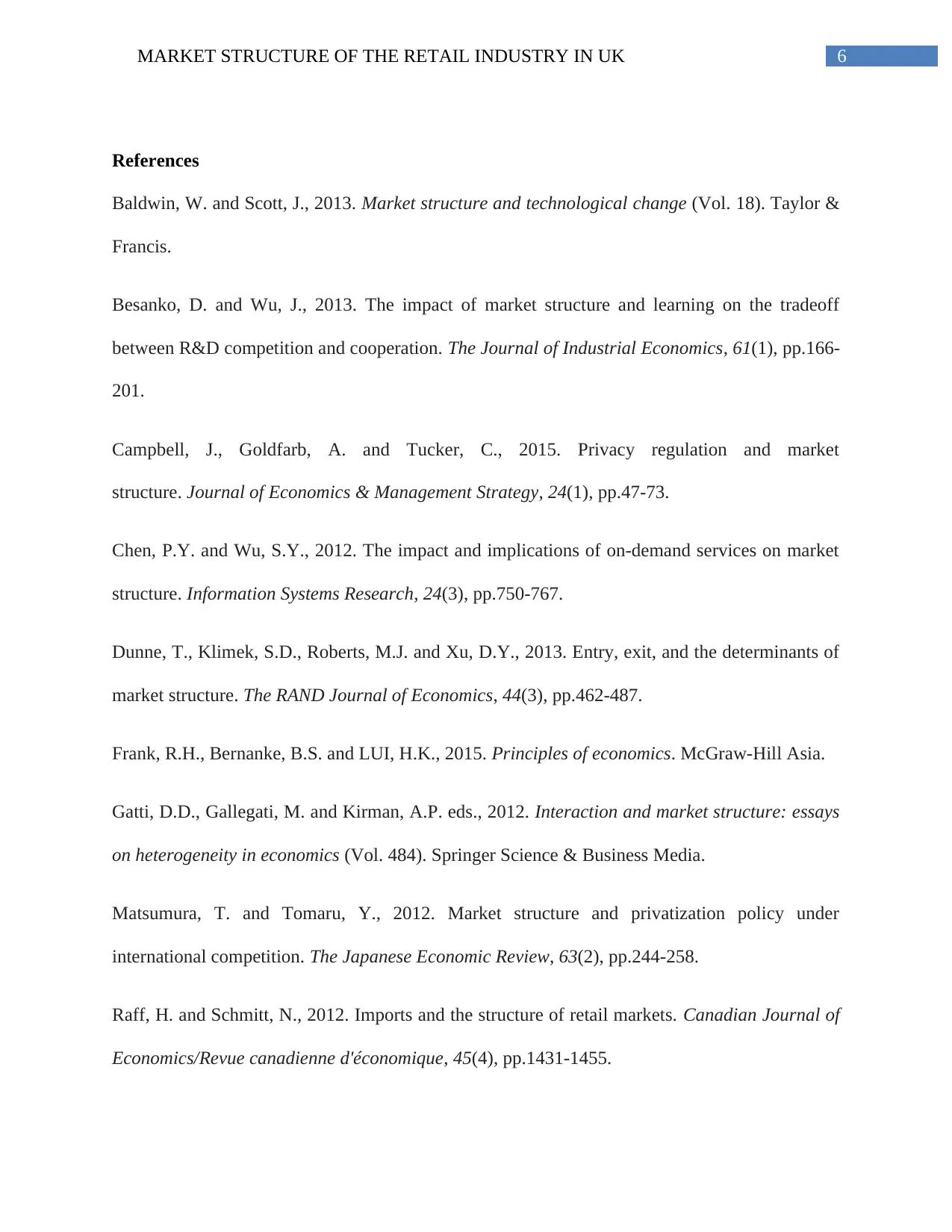
6MARKET STRUCTURE OF THE RETAIL INDUSTRY IN UK
References
Baldwin, W. and Scott, J., 2013. Market structure and technological change (Vol. 18). Taylor &
Francis.
Besanko, D. and Wu, J., 2013. The impact of market structure and learning on the tradeoff
between R&D competition and cooperation. The Journal of Industrial Economics, 61(1), pp.166-
201.
Campbell, J., Goldfarb, A. and Tucker, C., 2015. Privacy regulation and market
structure. Journal of Economics & Management Strategy, 24(1), pp.47-73.
Chen, P.Y. and Wu, S.Y., 2012. The impact and implications of on-demand services on market
structure. Information Systems Research, 24(3), pp.750-767.
Dunne, T., Klimek, S.D., Roberts, M.J. and Xu, D.Y., 2013. Entry, exit, and the determinants of
market structure. The RAND Journal of Economics, 44(3), pp.462-487.
Frank, R.H., Bernanke, B.S. and LUI, H.K., 2015. Principles of economics. McGraw-Hill Asia.
Gatti, D.D., Gallegati, M. and Kirman, A.P. eds., 2012. Interaction and market structure: essays
on heterogeneity in economics (Vol. 484). Springer Science & Business Media.
Matsumura, T. and Tomaru, Y., 2012. Market structure and privatization policy under
international competition. The Japanese Economic Review, 63(2), pp.244-258.
Raff, H. and Schmitt, N., 2012. Imports and the structure of retail markets. Canadian Journal of
Economics/Revue canadienne d'économique, 45(4), pp.1431-1455.
References
Baldwin, W. and Scott, J., 2013. Market structure and technological change (Vol. 18). Taylor &
Francis.
Besanko, D. and Wu, J., 2013. The impact of market structure and learning on the tradeoff
between R&D competition and cooperation. The Journal of Industrial Economics, 61(1), pp.166-
201.
Campbell, J., Goldfarb, A. and Tucker, C., 2015. Privacy regulation and market
structure. Journal of Economics & Management Strategy, 24(1), pp.47-73.
Chen, P.Y. and Wu, S.Y., 2012. The impact and implications of on-demand services on market
structure. Information Systems Research, 24(3), pp.750-767.
Dunne, T., Klimek, S.D., Roberts, M.J. and Xu, D.Y., 2013. Entry, exit, and the determinants of
market structure. The RAND Journal of Economics, 44(3), pp.462-487.
Frank, R.H., Bernanke, B.S. and LUI, H.K., 2015. Principles of economics. McGraw-Hill Asia.
Gatti, D.D., Gallegati, M. and Kirman, A.P. eds., 2012. Interaction and market structure: essays
on heterogeneity in economics (Vol. 484). Springer Science & Business Media.
Matsumura, T. and Tomaru, Y., 2012. Market structure and privatization policy under
international competition. The Japanese Economic Review, 63(2), pp.244-258.
Raff, H. and Schmitt, N., 2012. Imports and the structure of retail markets. Canadian Journal of
Economics/Revue canadienne d'économique, 45(4), pp.1431-1455.
Paraphrase This Document
Need a fresh take? Get an instant paraphrase of this document with our AI Paraphraser
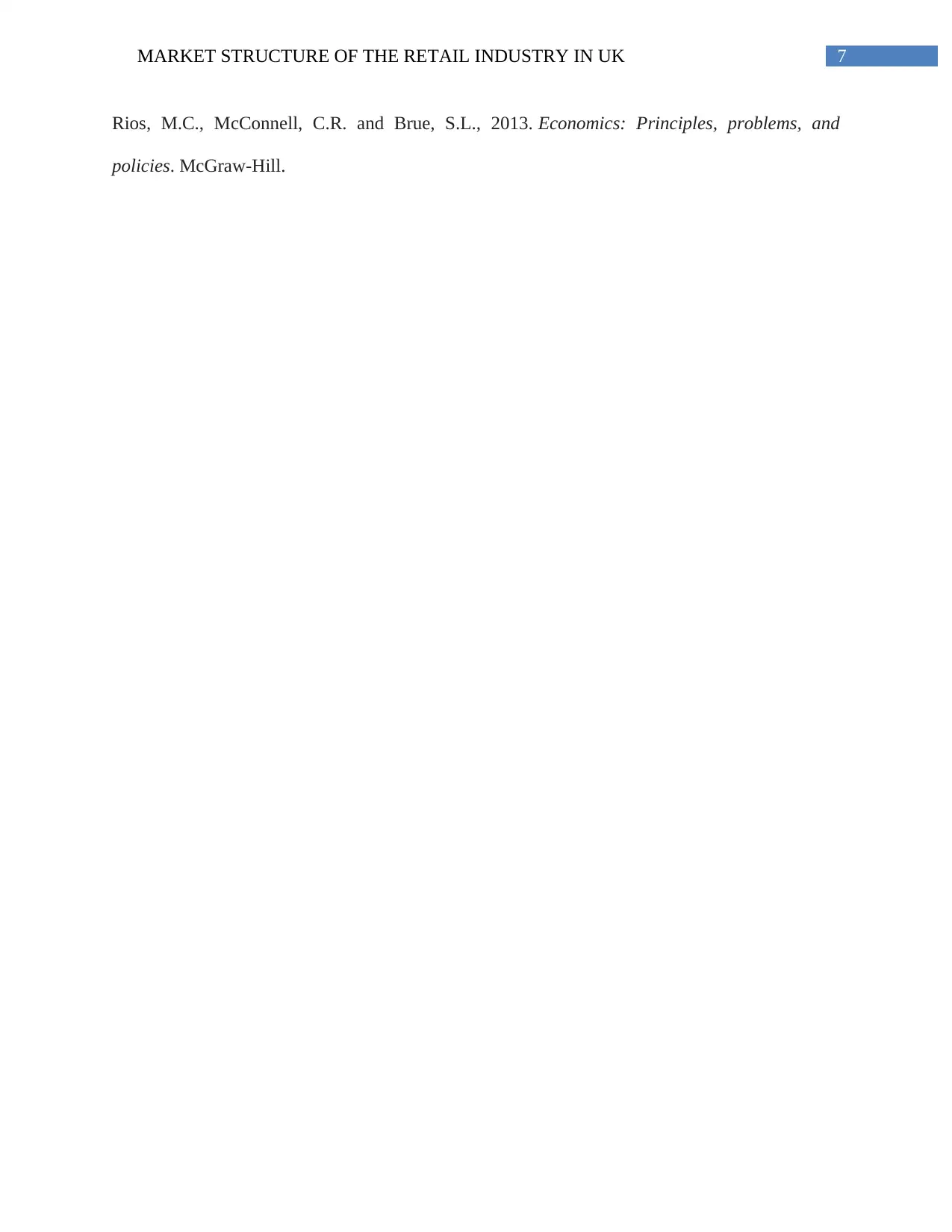
7MARKET STRUCTURE OF THE RETAIL INDUSTRY IN UK
Rios, M.C., McConnell, C.R. and Brue, S.L., 2013. Economics: Principles, problems, and
policies. McGraw-Hill.
Rios, M.C., McConnell, C.R. and Brue, S.L., 2013. Economics: Principles, problems, and
policies. McGraw-Hill.
1 out of 8
Related Documents
Your All-in-One AI-Powered Toolkit for Academic Success.
+13062052269
info@desklib.com
Available 24*7 on WhatsApp / Email
![[object Object]](/_next/static/media/star-bottom.7253800d.svg)
Unlock your academic potential
Copyright © 2020–2025 A2Z Services. All Rights Reserved. Developed and managed by ZUCOL.



